How to Draw Trees
Updated: 13 Sep 2021

In this guide, I will demonstrate how I simplify the drawing process and I hope that by the finish of information technology, you volition be able to draw your favorite tree.
In order to draw realistic trees with pen and ink, it is important to pay attention to accuracy of the class (construction), and to learn how to create the illusion of brightness values and transitions with pens.
Bamboo
When looking at Whatsoever tree, nosotros examine its basic shapes.
It is a good practice to draw its simple shapes showtime:
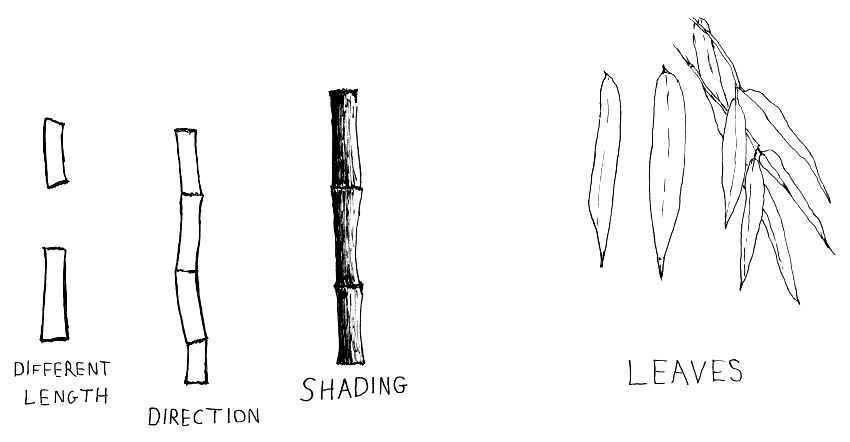
In one case we sympathise these simple shapes, we tin use our artistic license and our noesis to recreate information technology.
There is no signal drawing every single leaf as we see it (when using a reference image every bit a guide).
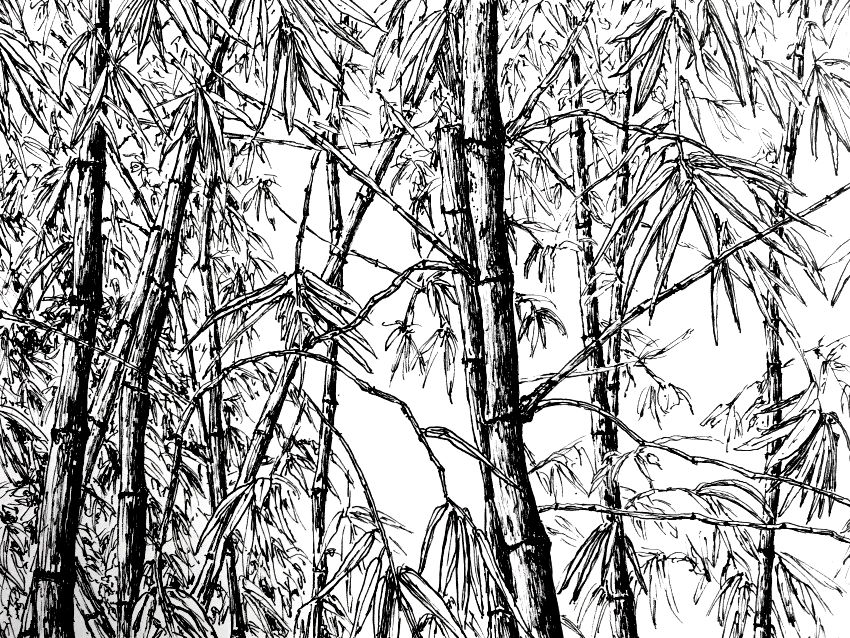 Bamboo pen drawing
Bamboo pen drawing
Banana Tree
For trees with big leaves, similar a assistant tree, first draw a study of the leaves from dissimilar angles.
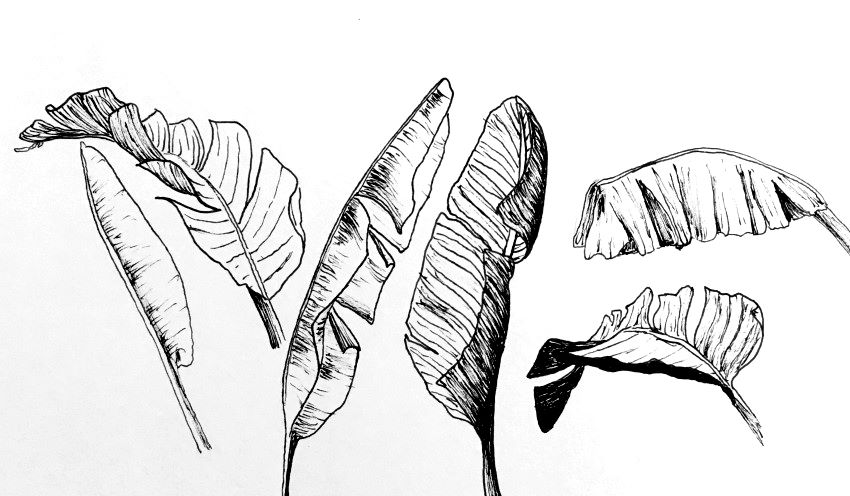
Make sure there is no symmetry, and that each leaf is unique, for a realistic result.
You can utilize markers; they work well with pens.
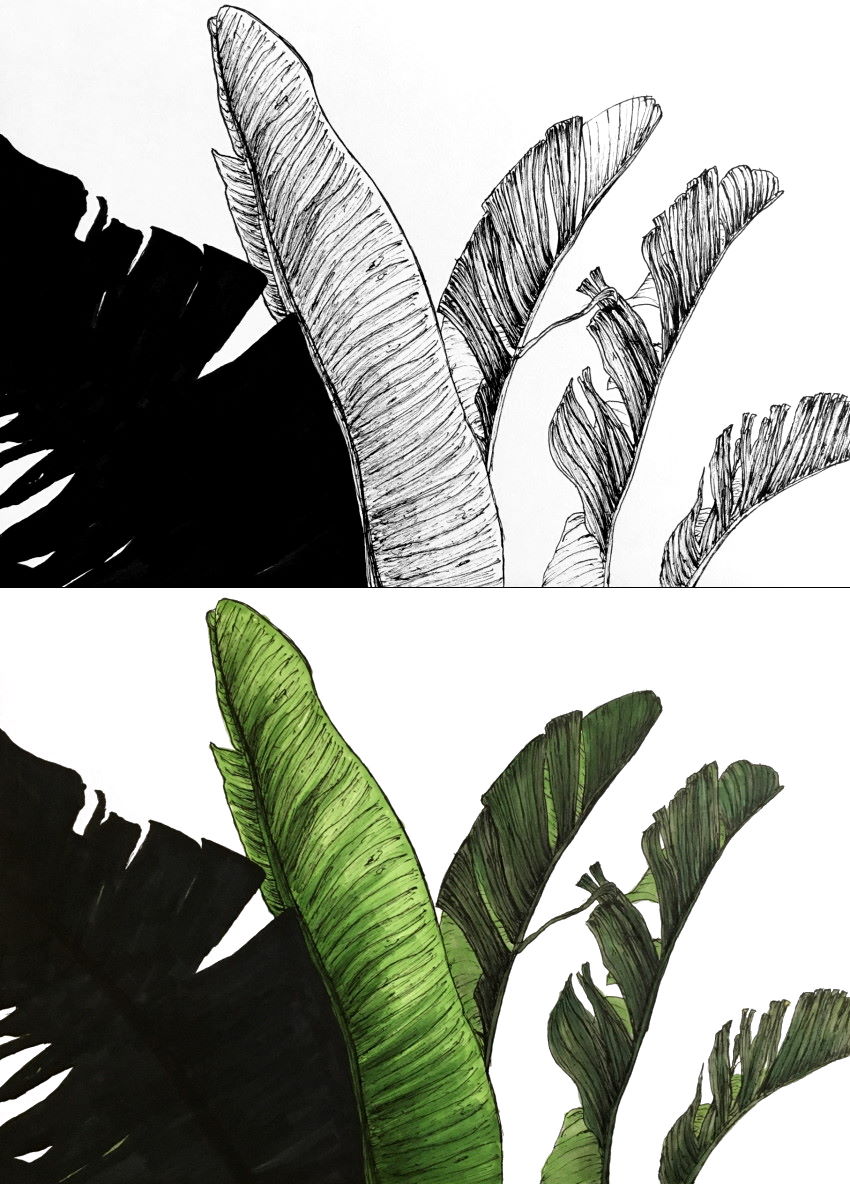
Olive Tree Trunk
Await at some reference images, or actual copse, earlier cartoon the tree trunk.
First, draw outlines to create the course (structure).
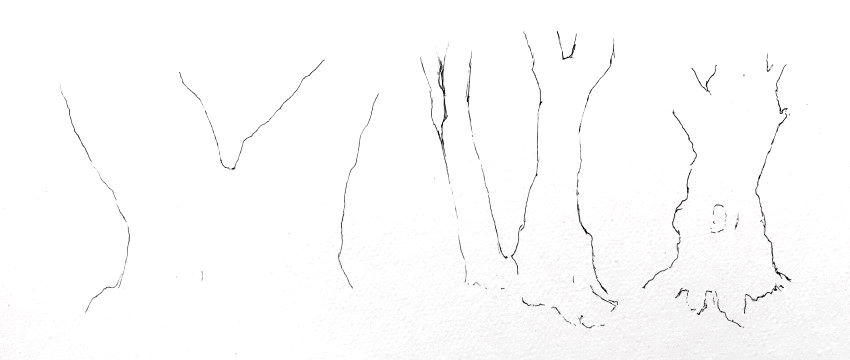
Next, add some guidelines and bones details.
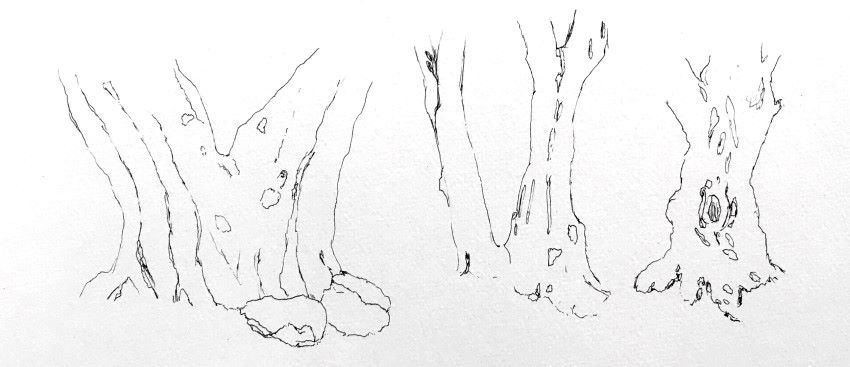
Concluding step is texture drawing.
Focus mainly on effulgence values, while drawing marks with shape and direction like the reference prototype.
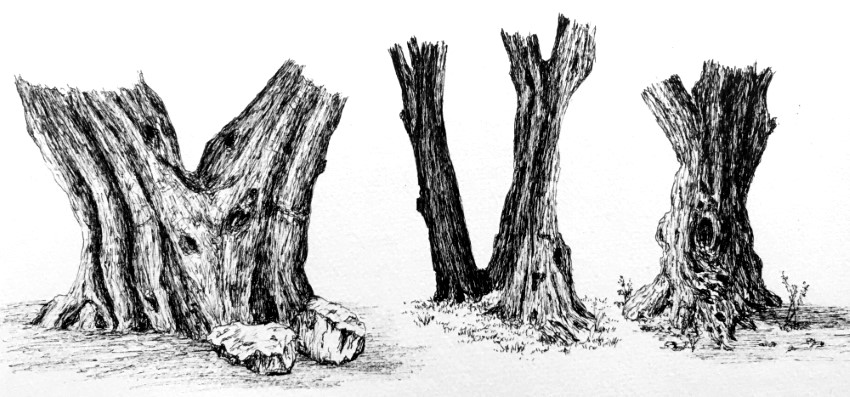 Olive tree trunks pen drawing
Olive tree trunks pen drawing
Recollect:
Each olive tree trunk has its own "personality", simply all olive trees share common bones shapes.
With practice, it is quite like shooting fish in a barrel to draw them from imagination.
How to Describe Leaves
Drawing leaves tin exist challenging. Understanding their structure and breaking the cartoon procedure into steps, will produce a satisfying and realistic event.
Each tree leaf is in different management, has a different degree of foreshortening and is overlapping other leaves.
Simply put, the form and texture of leaves is abstract and messy.
To draw that, nosotros need to be sketchy and loose with our marks, and to avoid whatever design!
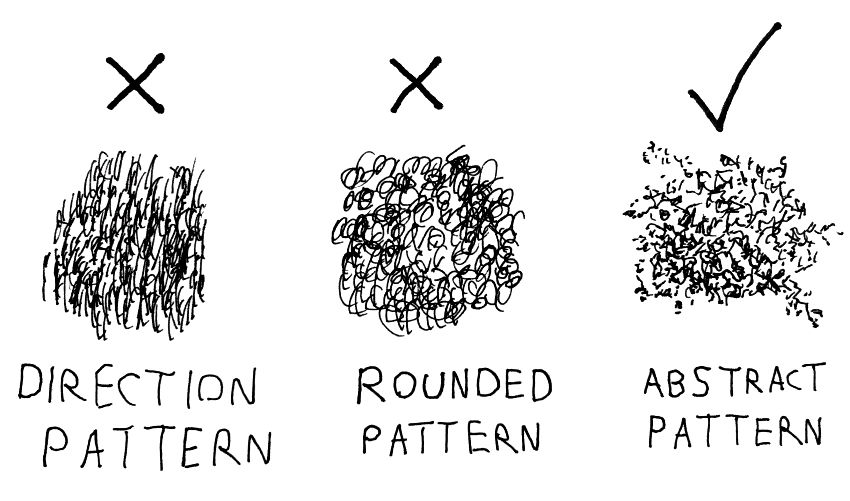
Adjacent step is to pay attention to brightness values. That is how we create the illusion of volume. Meaning, three-dimensional and not flat.
To create that illusion, we scribble more lines for darker values and fewer lines for brighter values:
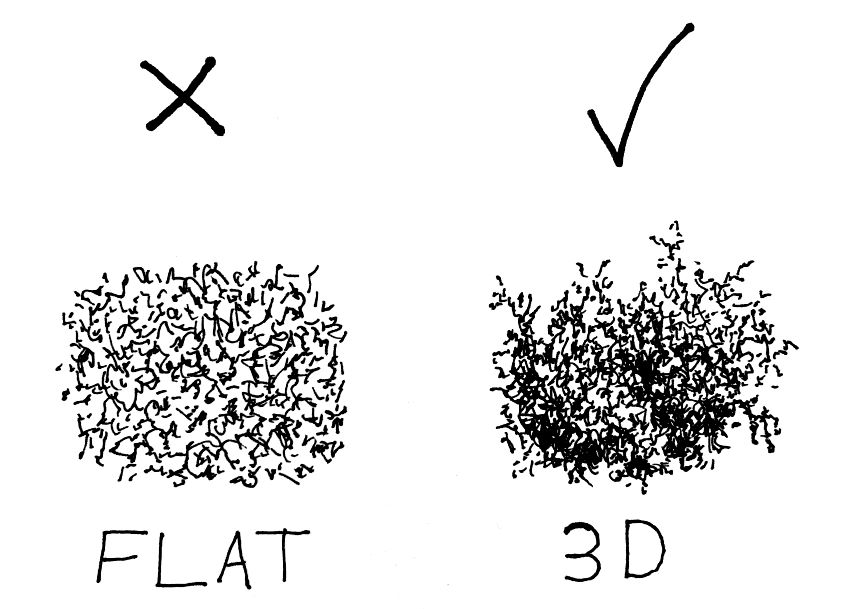
We as well pay attending to leaves size, depending on the tree blazon and how distant it is from the observer.
For large leaves, we sketch large marks and vice versa:
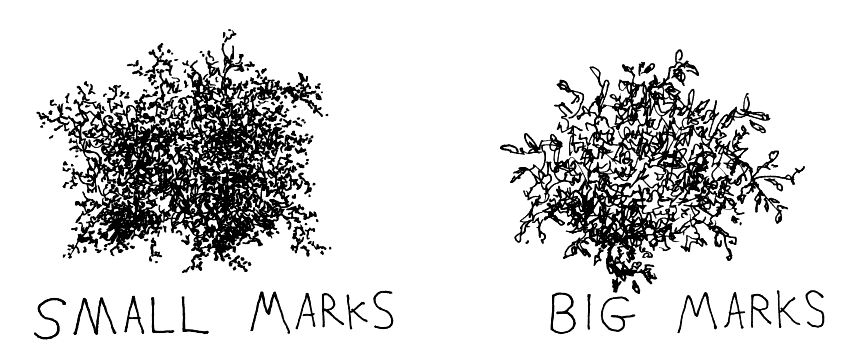
While the treetop is messy, at its edges, we add some indication of leaves type and size.
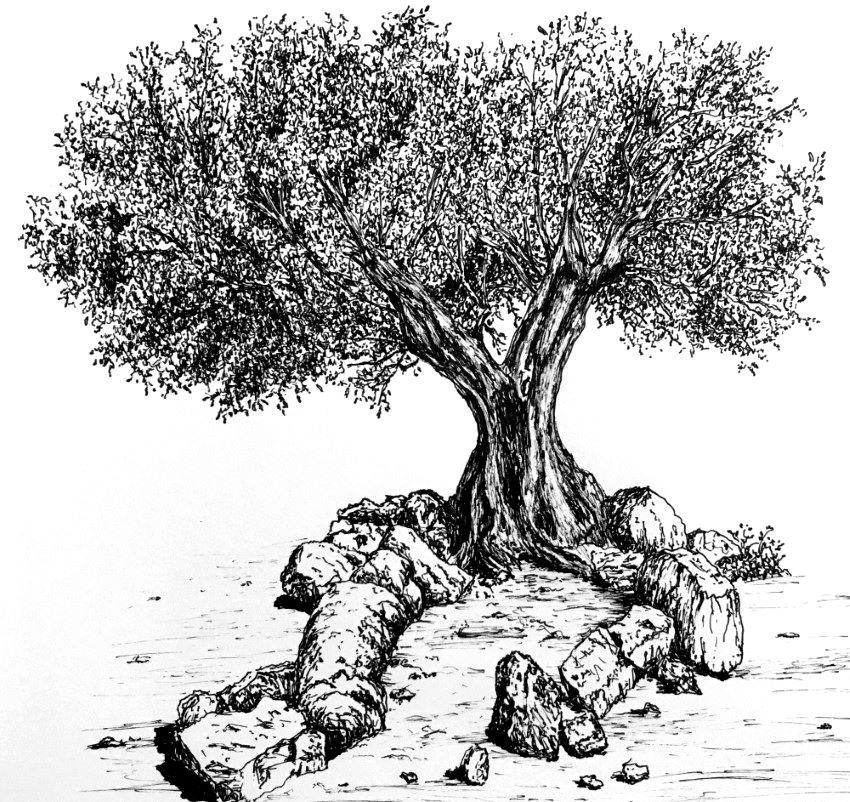 Olive tree pen drawing
Olive tree pen drawing
After agreement the characteristics of a specific tree (olive tree in this case), information technology is quite easy to draw it from imagination.
If some terms like foreshortening and overlapping are new to you, it is appropriate to read my commodity on how to draw with a sense of depth. It has 15 proven methods to add depth to your cartoon or painting.
Good to know:
Mostly, I utilize a pen with neb size 0.1. It is small enough to create fine details.
Photos & Contrast
When I am taking photos of a tree, I do it from several angles.
If possible, I circumvolve the tree to get a photo from every angle.
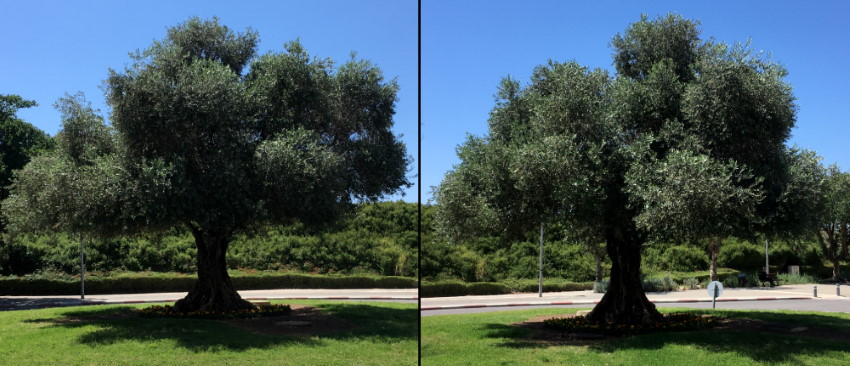
I select a photo that has high contrast equally my reference image.
Dissimilarity betwixt highlights and shadows is crucial for a drawing to stand out and to have presence.
Non plenty dissimilarity will lead to a flat drawing with no depth. Too much contrast will look cartoonish.
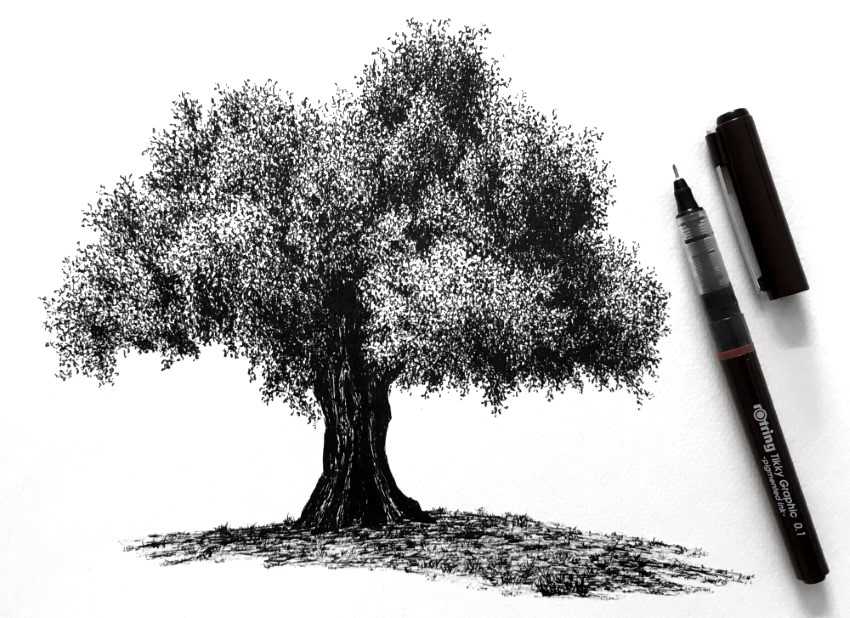 Olive tree drawing
Olive tree drawing
Pino Trees
Of import:
Before we dive into complex texturing and rendering, if you are a beginner, y'all might want to practice the next step.
Create any random tree shape, sketch some random marks to make full it up and so, draw more sketchy marks in one side and at the bottom of the tree.
This should not take more than five minutes! The advanced texture you will see later this example is just a matter of many hours of practice to refine the texture marks.
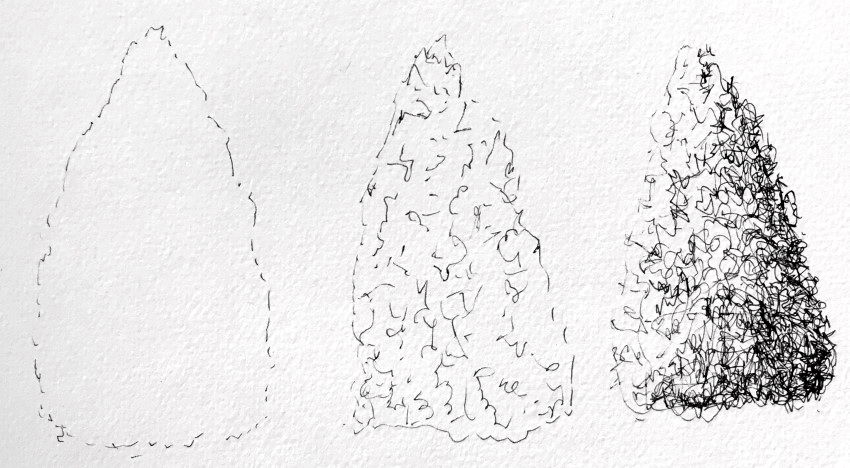
Pino trees are relatively easy to describe from imagination.
They have very small-scale, needle-like leaves.
I similar to kickoff by gently drawing the form so fill it with small, random marks that are Non in whatsoever specific direction or with reoccurring shape.
Last step is to create more marks for darker areas, depending on the direction of light you choose.
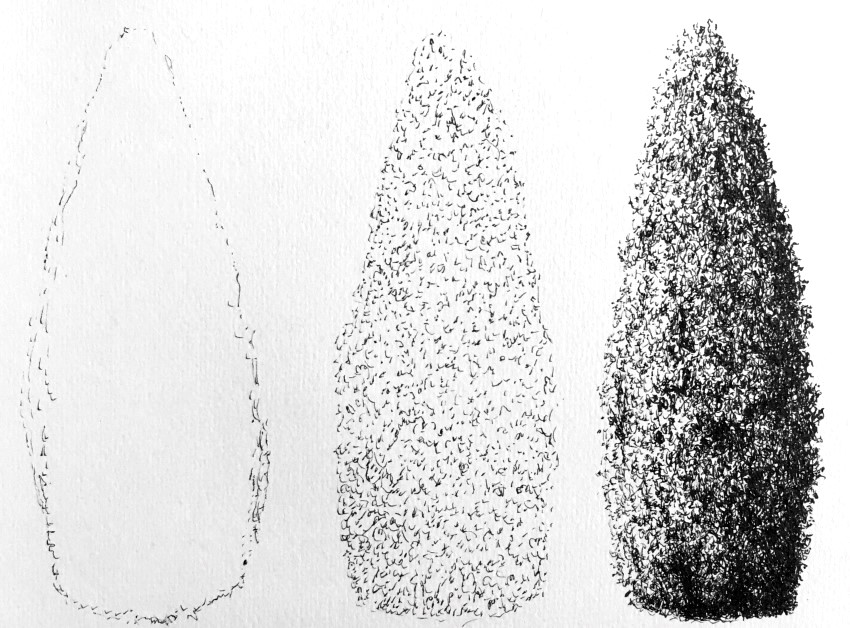
Pine trees come in many types and shapes.
Looking at a reference image can help at the offset, just as a guide to depict the form and to pay attention to dark and light areas.
Other than that, effort to be loose and sketchy with your marks.
When drawing a close-up view, you can bespeak the needle-like leaves at the edges of the tree.
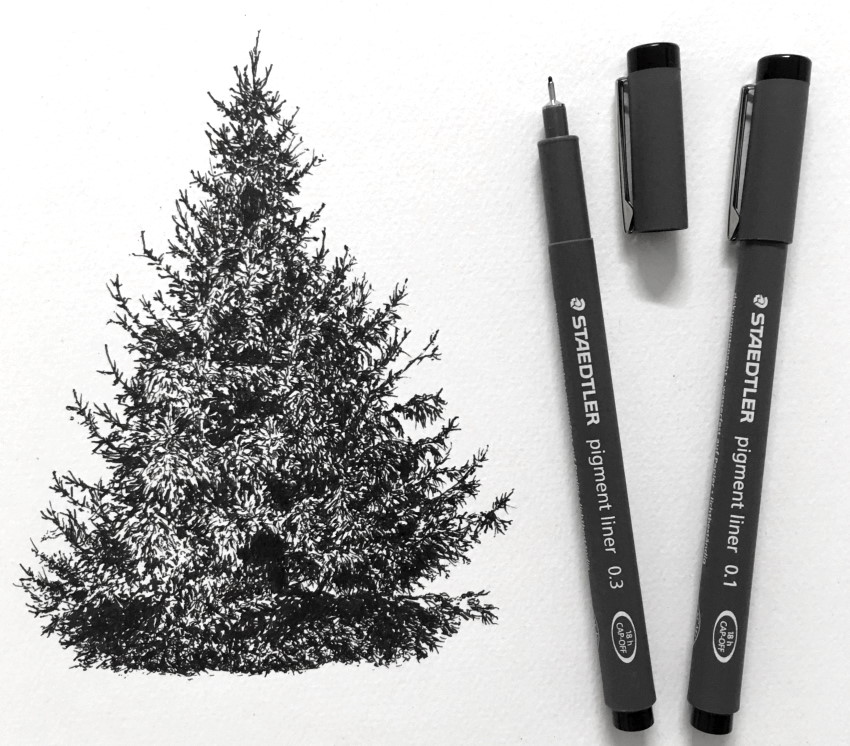 Pine tree pen drawing
Pine tree pen drawing
Snowy Pine Tree
A pen has simply one effulgence value. Therefore, we take to employ unlike techniques to create the illusion of transitions in brightness values.
One technique (or way) is to utilise hatching. Hatching means drawing parallel lines.
Past drawing lines with different degree of spacing betwixt them (or with dissimilar line width), we can create an illusion of dissimilar brightness values.
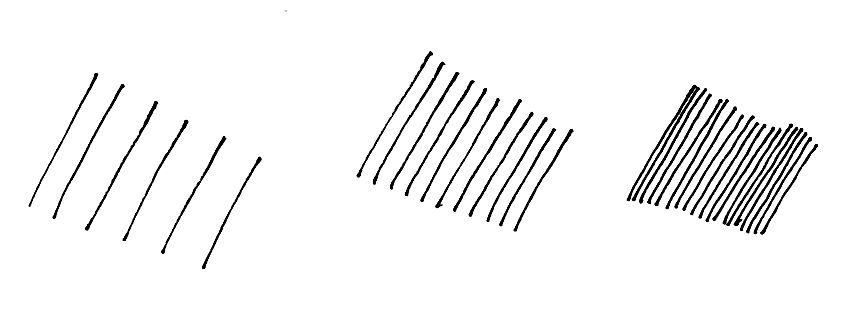
Another method is to use cross-hatching.
Cantankerous-hatching means drawing sets of parallel lines in unlike direction. The more cross-hatching sets we describe, the darker it will look for the observer.

We tin utilize Whatever pen for drawing. I prefer artist-grade technical pens (also fineliners). They create lines with stock-still width and their ink is made of pigments and is very durable and lightfast.
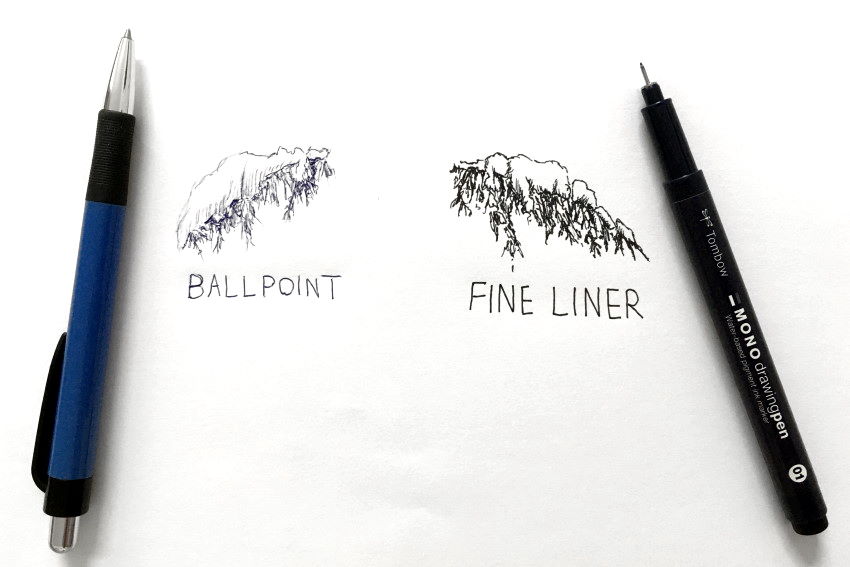
For the snow part, we can leave it empty ("white") or we can use hatching in some areas.
In this instance, I used some hatching and some marks with very low-cal grayness marker.
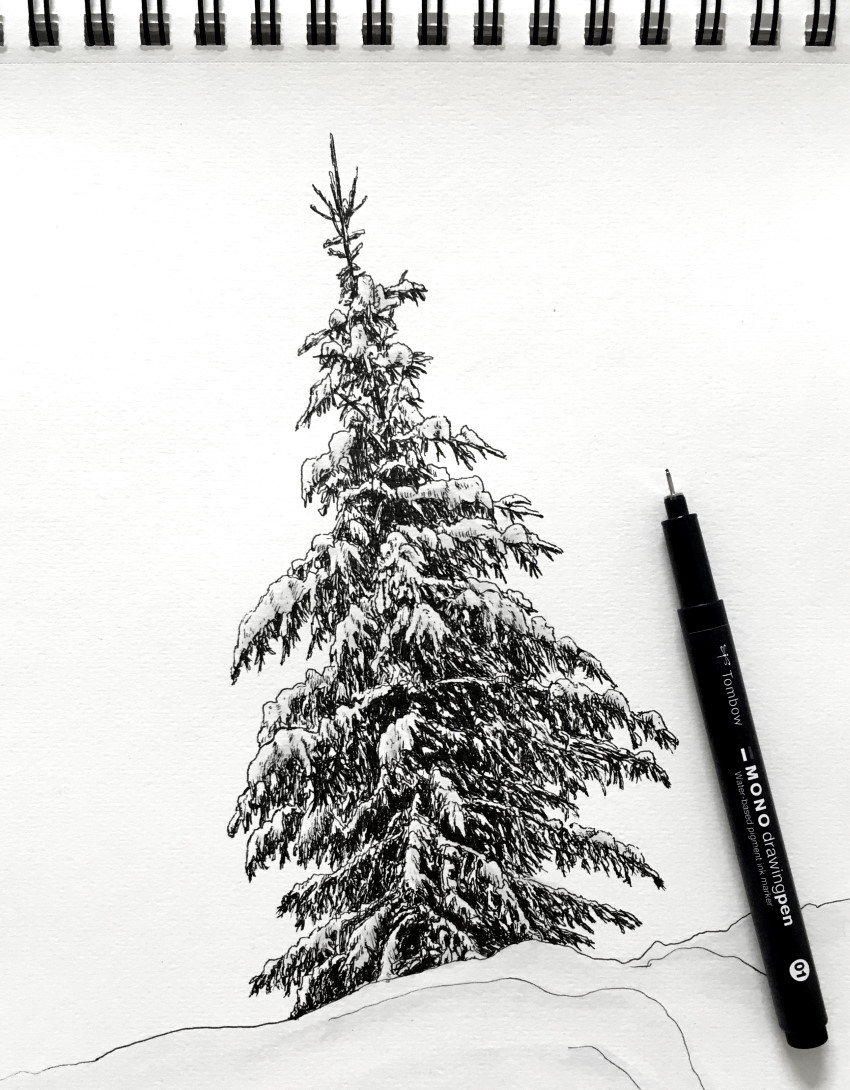 Snowy Pine tree
Snowy Pine tree
If you want to know more near markers, visit my markers review for artists.
Christmas Tree
A Christmas tree is just another pine tree, just with decorations.
To add some baubles, get-go draw their shape and then endeavor different types of hatching, cross-hatching and stippling.
Stippling is a cartoon technique using dots. The more dots yous add in one area, the darker it will wait.
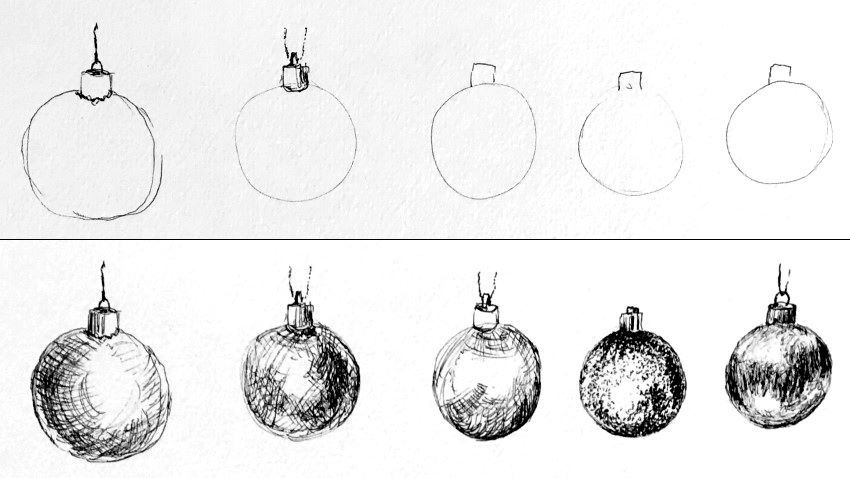
You can add other decorations to your Christmas tree.
It is all-time to beginning sketch some exam drawings on a different paper, to run into what works, before adding them to your drawing.
To add boxes in perspective, you should be familiar with linear perspective drawing, and learn to draw from imagination.

Tip:
If you find it difficult to depict a tree with a pen, you lot tin can always start with a pencil.
When you lot achieve a satisfying result, you can go over it with a pen, and gently erase the pencil marks.
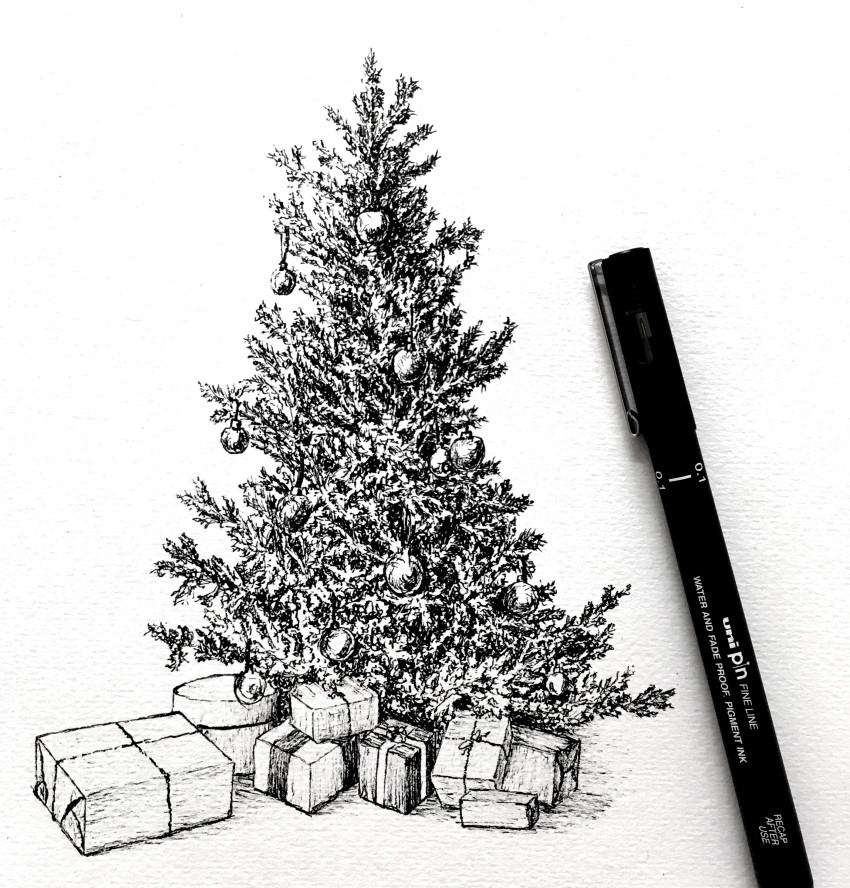 Christmas tree
Christmas tree
Drawing with White Pens
With white pens, nosotros pay attending to the same cartoon fundamentals.
While with blackness pens we draw more lines for darker areas, with white pens we depict more lines for light/brilliant areas.
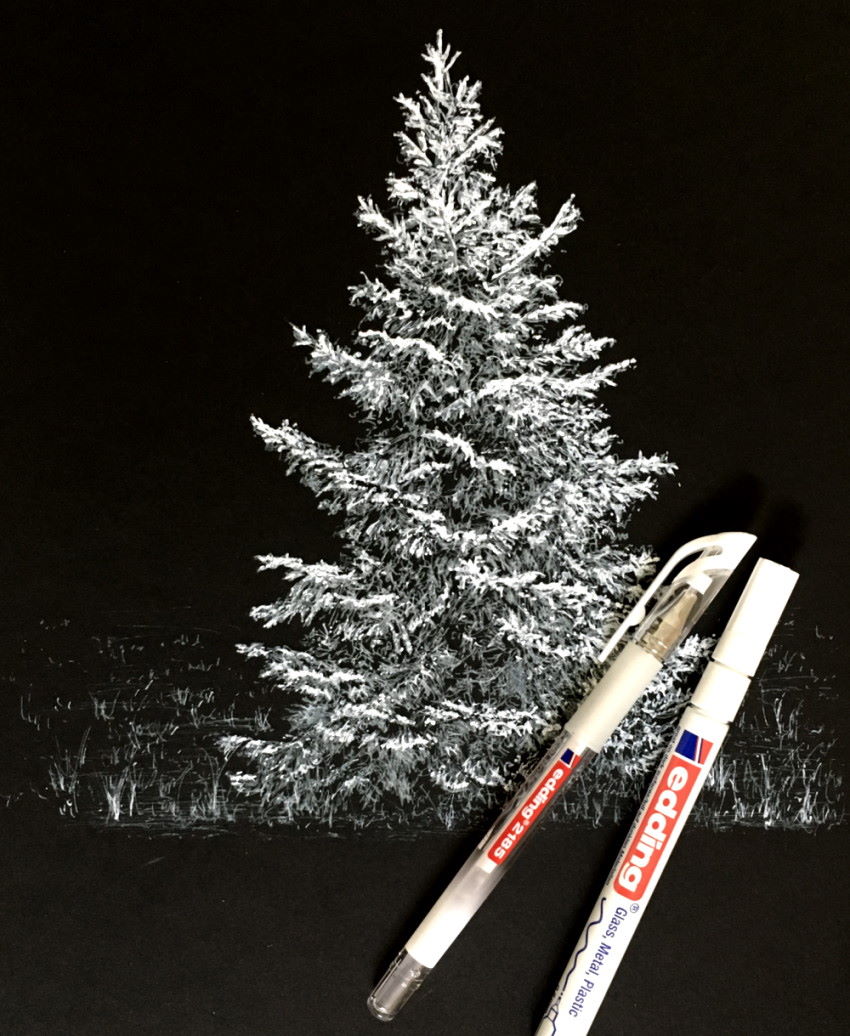
These pens are most effective on black (or dark) newspaper, and for highlights.
Keep in mind:
White pens are designed for covering.
Drawing with a blackness pen (which has ink) over white areas, may ruin the pen's nib, because it volition exist covered with the white substance.
Aspen & Birch Trees
Aspen & birch tree trunks are easy to draw when doing information technology in steps.
We draw the form offset:
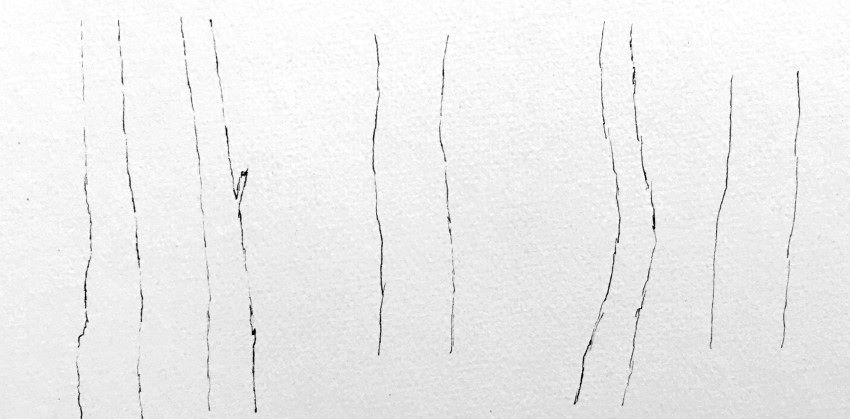
Then, we add some basic details:
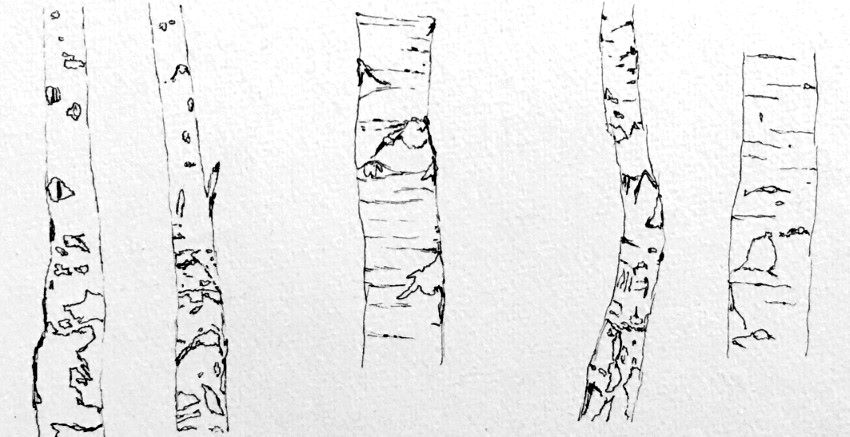
Finally, nosotros draw some effulgence values and texture:
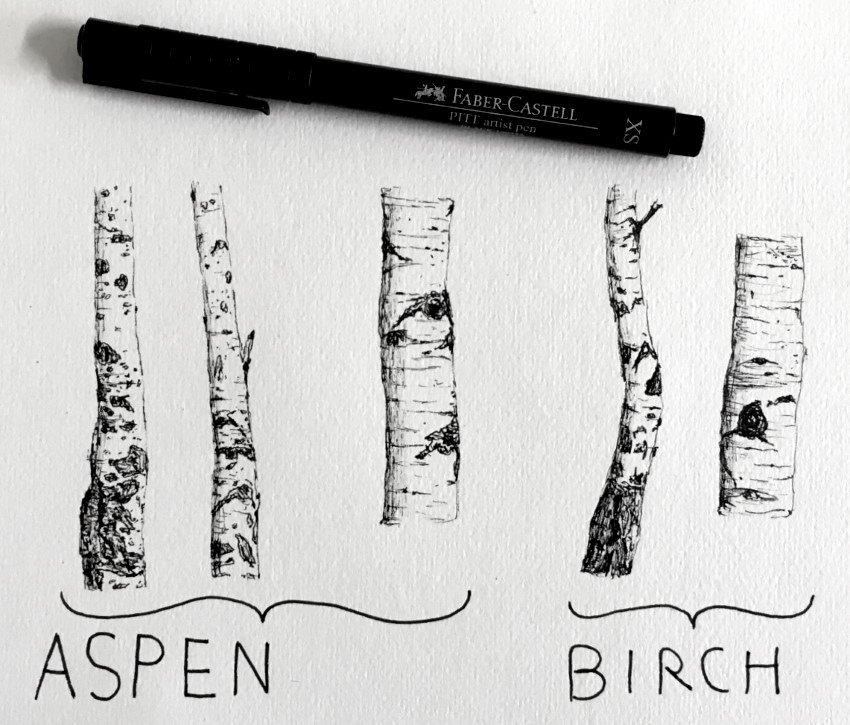 Birch & aspen tree trunks
Birch & aspen tree trunks
We can employ gray marker pens for coloring:
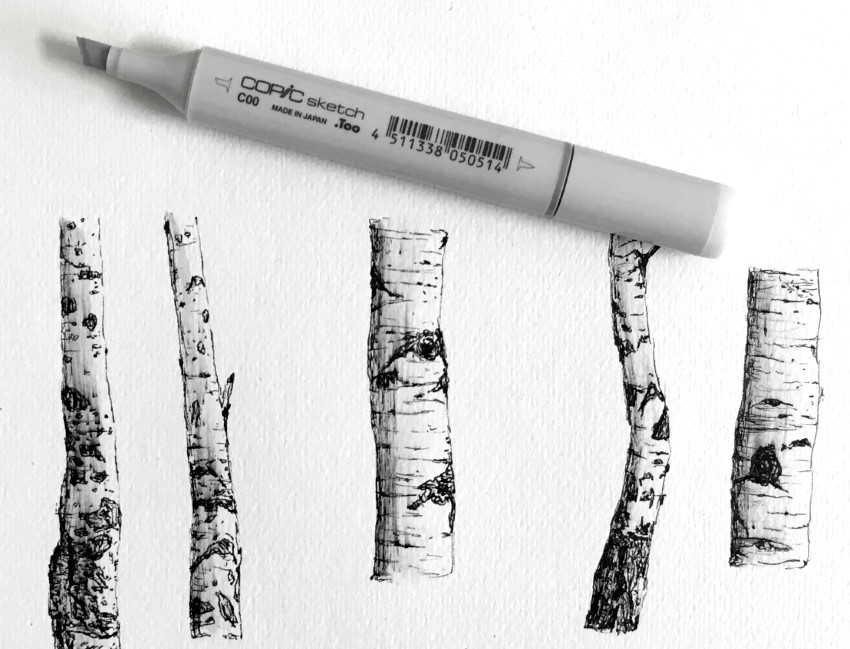
Overlapping
Overlapping ways an object that partially covers some other object.
When we come across an object that overlaps another object, we assume that this object is in front of the object information technology covers.
Therefore, we utilize overlap to create the illusion of depth on a apartment paper.
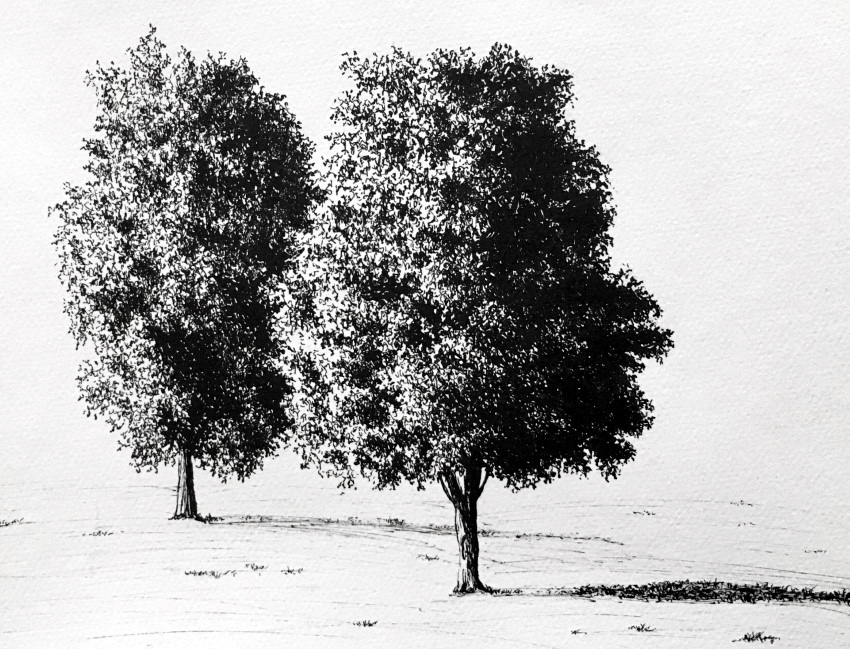 Overlapping trees
Overlapping trees
Because we cannot erase pen marks, we draw foreground objects first!
If we want to draw a house in front of a tree, we draw the house kickoff:
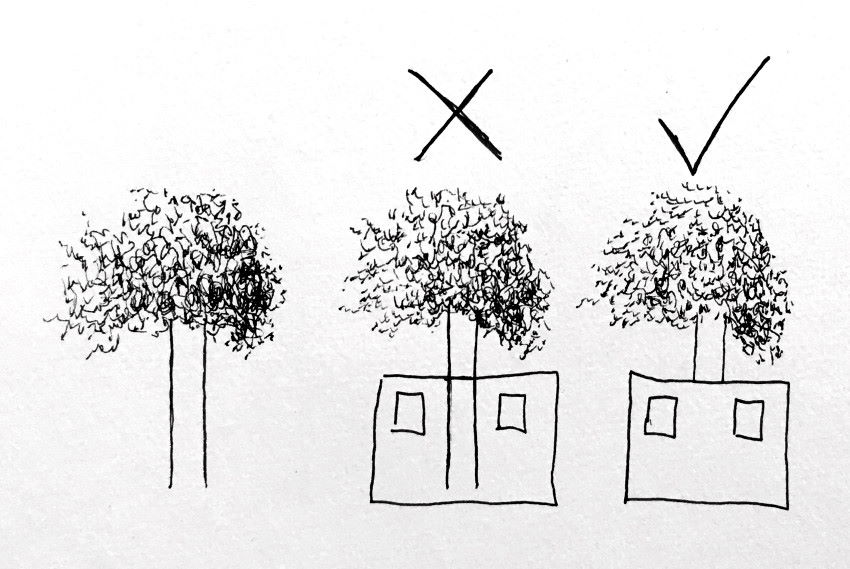
We do the same for tree branches.
Start, we depict the branch that overlaps a tree, then the tree trunk.
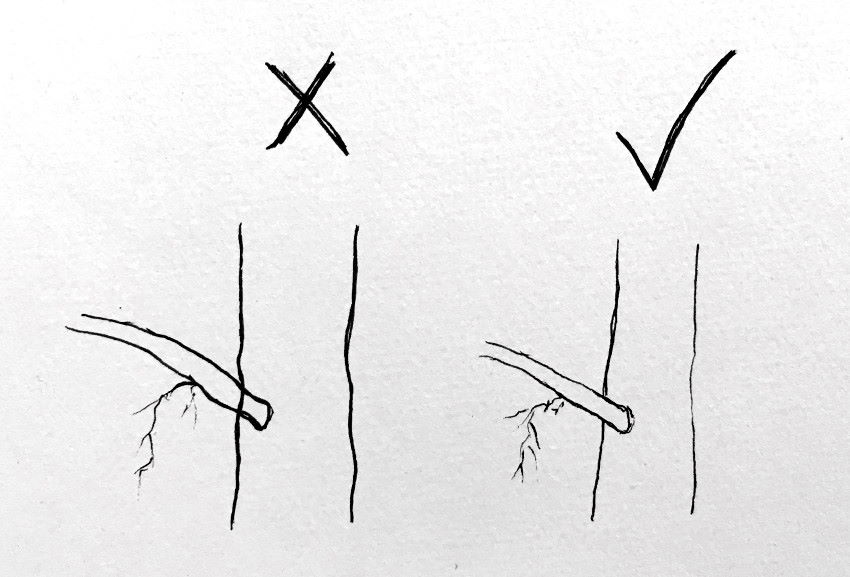
For trees that have a circuitous structure, with many branches, nosotros tin can use a pencil to draw the basic shapes.
When we are happy with the result, we can draw with a pen, and gently erase the pencil marks.
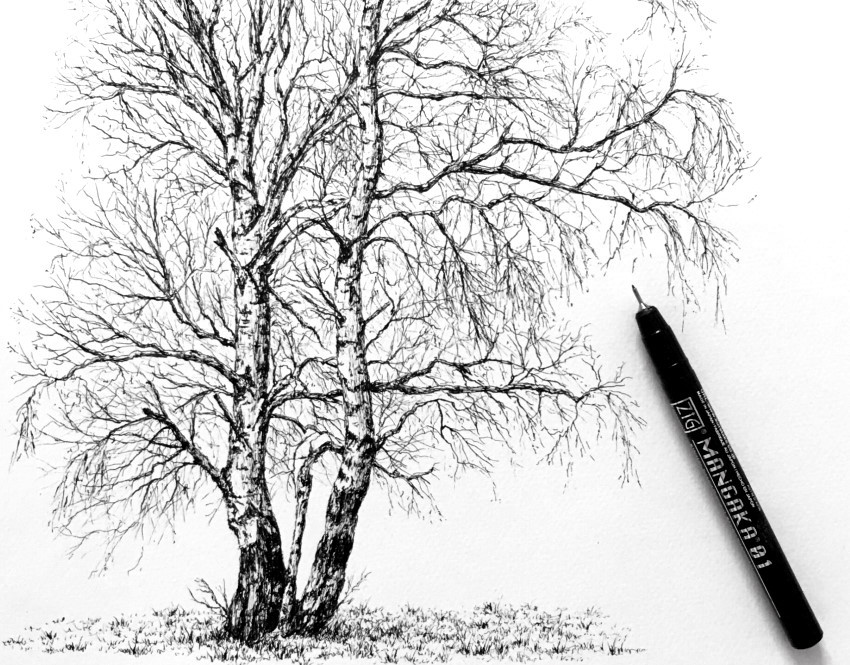 Birch copse pen drawing
Birch copse pen drawing
Transitions
Transitions are part of drawing (and painting) fundamentals. They exist everywhere!
For example, dissimilar areas of a flat aeroplane will have different relationships with any calorie-free source, reflections and shadows.
Therefore, we always need to expect for transitions (in effulgence values) for our drawing to wait realistic and natural.
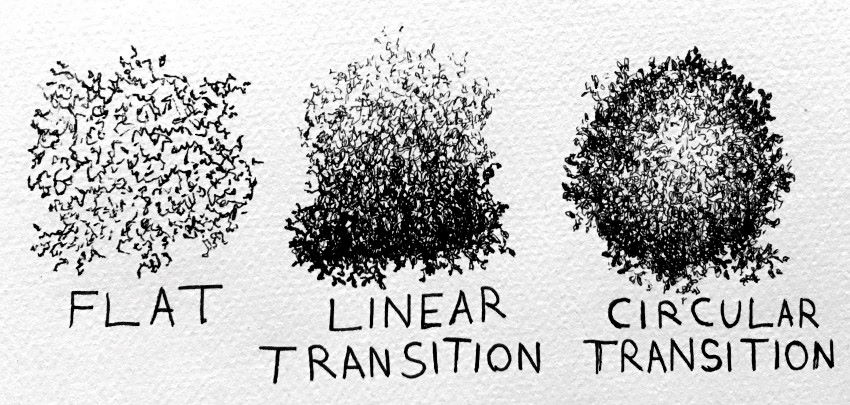
Kickoff, look for light and dark areas.
Then, wait for transitions within each area. Transitions from dark to light, from light to lighter and from dark to darker.
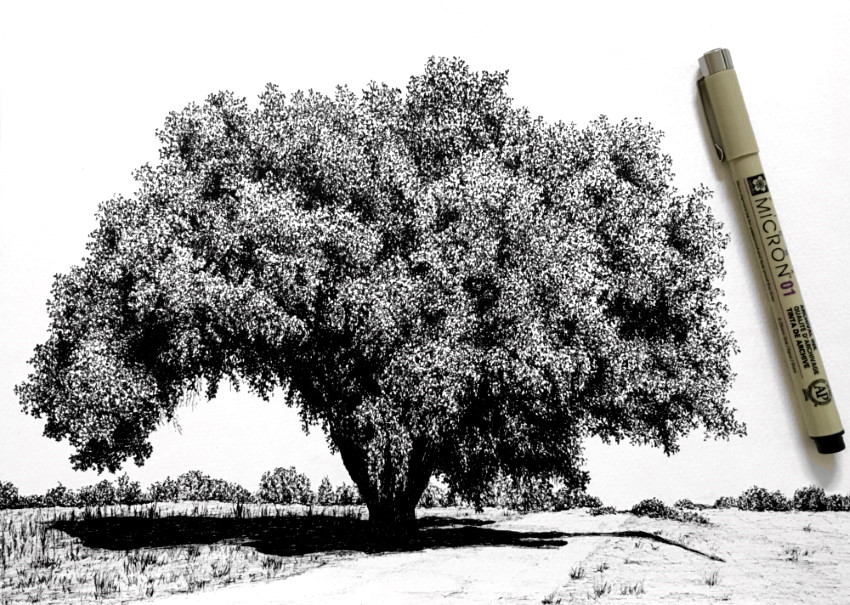 Oak tree pen drawing
Oak tree pen drawing
By cartoon with NO transitions (and using difficult edges), we tin create something that looks unnatural, as opposed to something realistic with transitions.
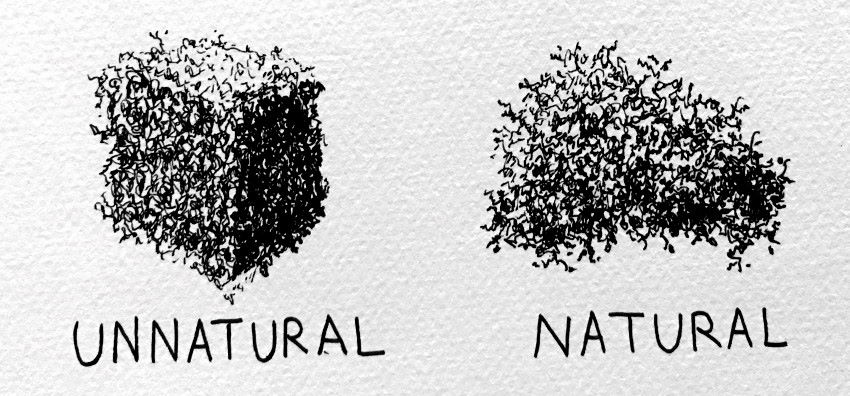
The aforementioned mode a gardener trims bushes and trees, we can apply our artistic license to create something that looks artificial or human-made:
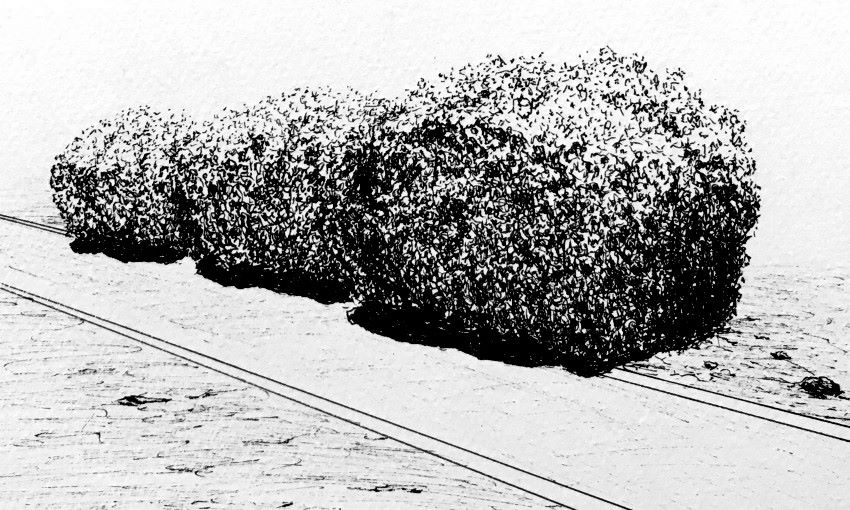
Artistic license means to use our knowledge and feel.
In one case we sympathize how to draw leaves, nosotros can draw anything with leaves texture. Objects, figures, vehicles or even a refrigerator:
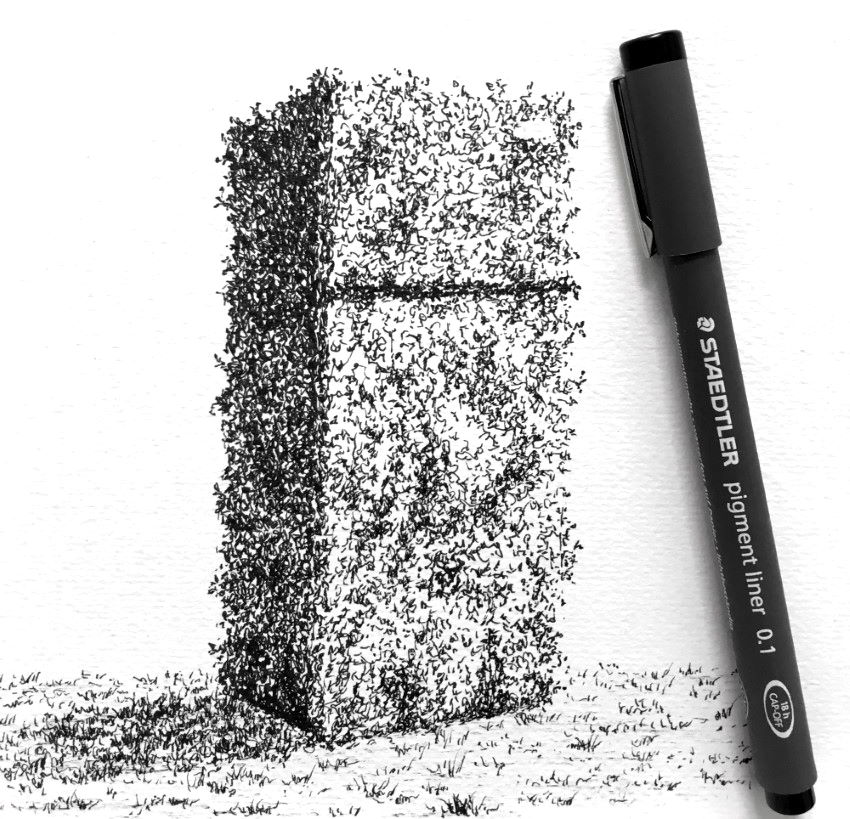
Skillful to know:
Transitions are not limited to brightness values. Transitions be in colors, texture, edges & temperature (transition from warm colors to absurd colors).
If y'all are struggling with realistic drawing, yous might want to read my realistic pencil-drawing guide. It covers the four important fundamentals (accuracy of the grade, brightness values, edges and transitions).
Weeping Willow
A weeping willow tree is a bit catchy to draw.
Its leaves are like shooting fish in a barrel to describe at an upwards-close look. Equally nosotros get farther abroad, we tin meet long clusters of leaves with no single leaf shape.
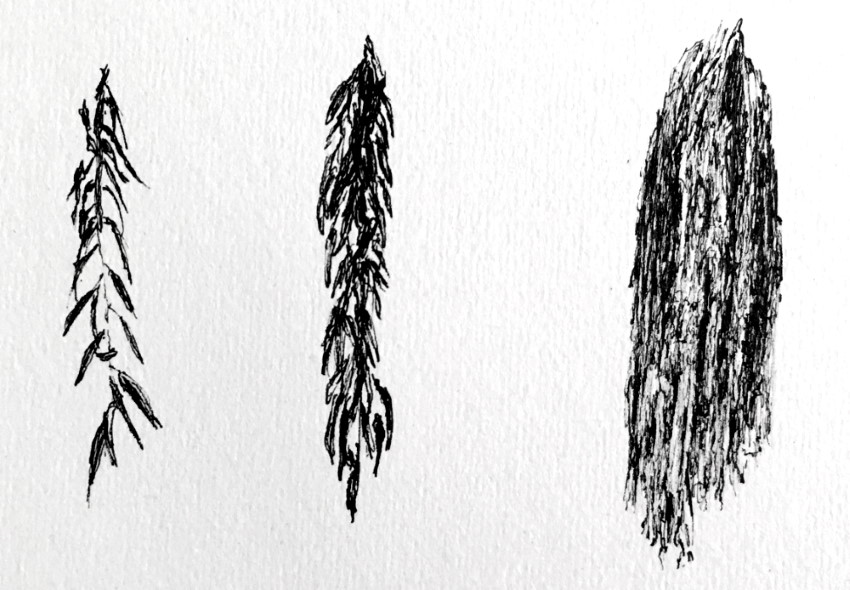
We can start past cartoon an outline for the tree form. Do it gently.
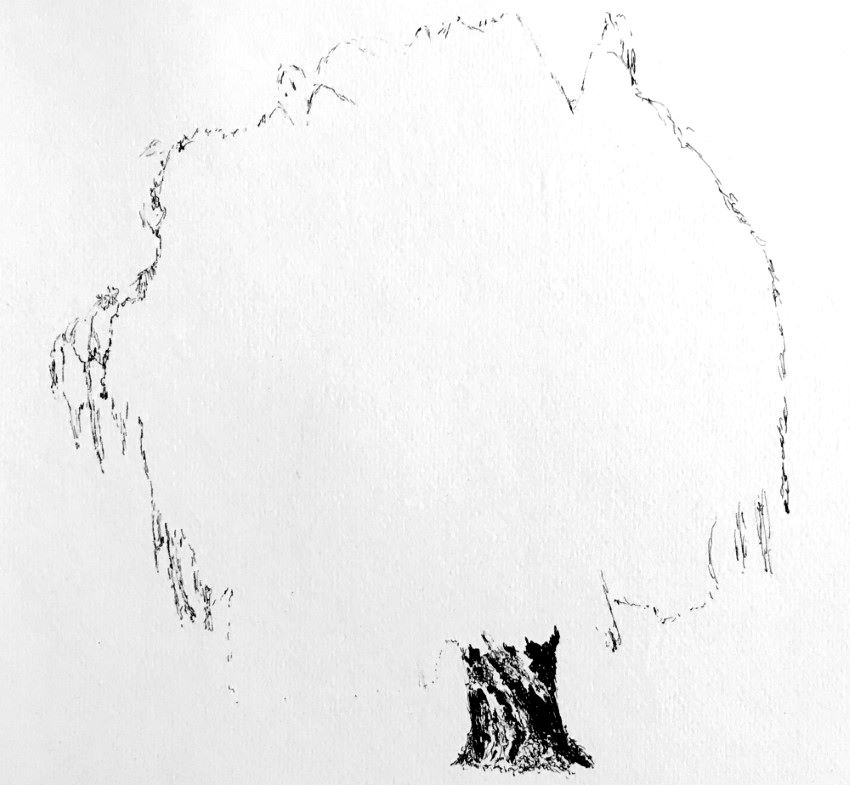
Then, one fashion is to draw the treetop (crown), section past section.
Alternatively, like in this example, we can depict the nighttime values first.
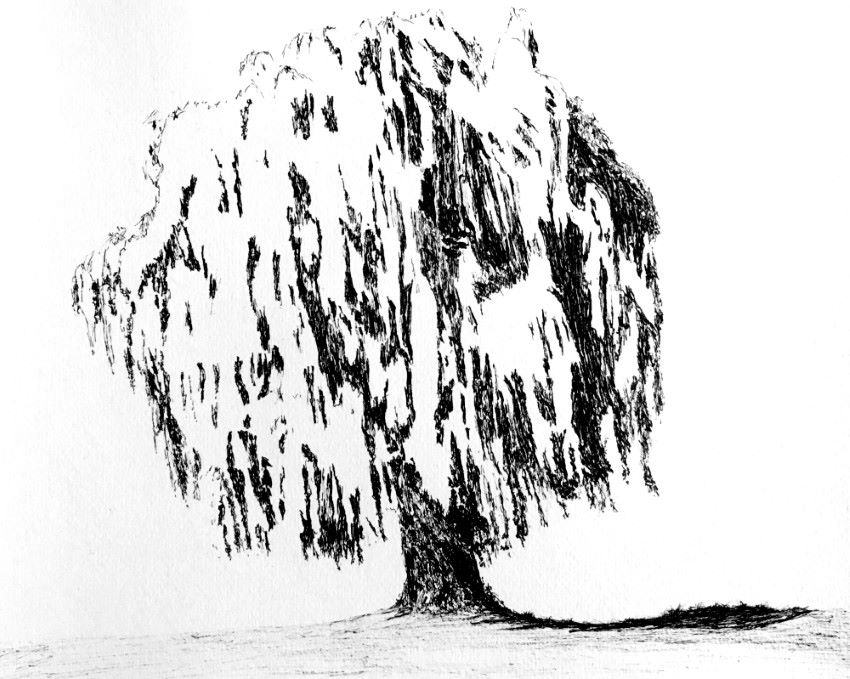
Something to consider:
Equally mentioned higher up, a pen has ane brightness value (usually black, though other colors exist).
By drawing gently and swiftly, with a sharp angle, nosotros can produce lines that are less defined and therefore, with a lighter value.
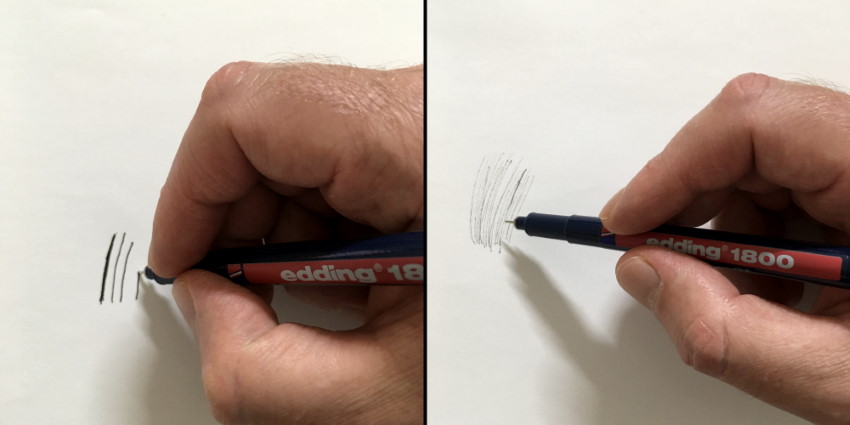
Last step is to add the light values.
Pay attention to effulgence values, transitions and texture. Be abstract with your marks, withal with a sense of management.
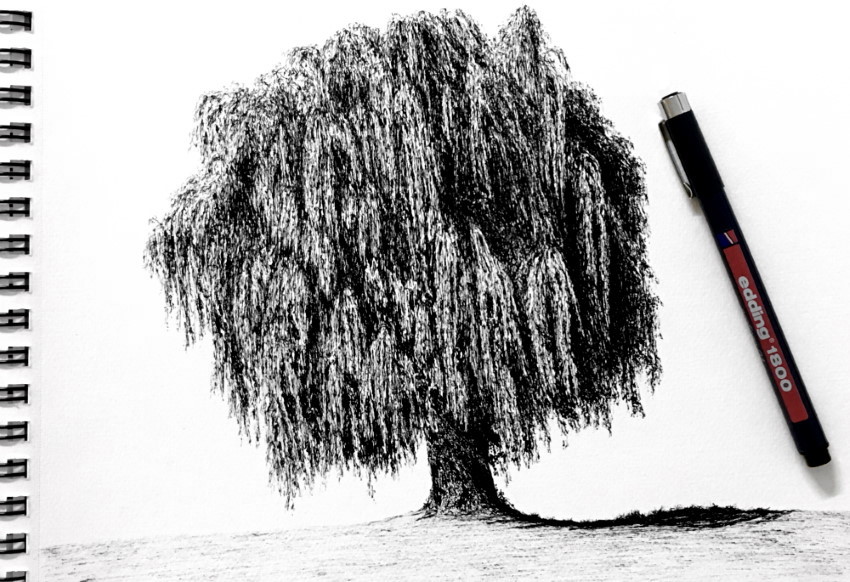 Weeping Willow pen drawing
Weeping Willow pen drawing
How to Describe Huge Trees
For some large trees, similar Ficus, it is improve to use a big paper sheet (A3 in this case).
If the tree is likewise complex to draw, we can describe a filigree (softly with a pencil), to separate the newspaper into smaller sections (and use the same grid for our reference image).
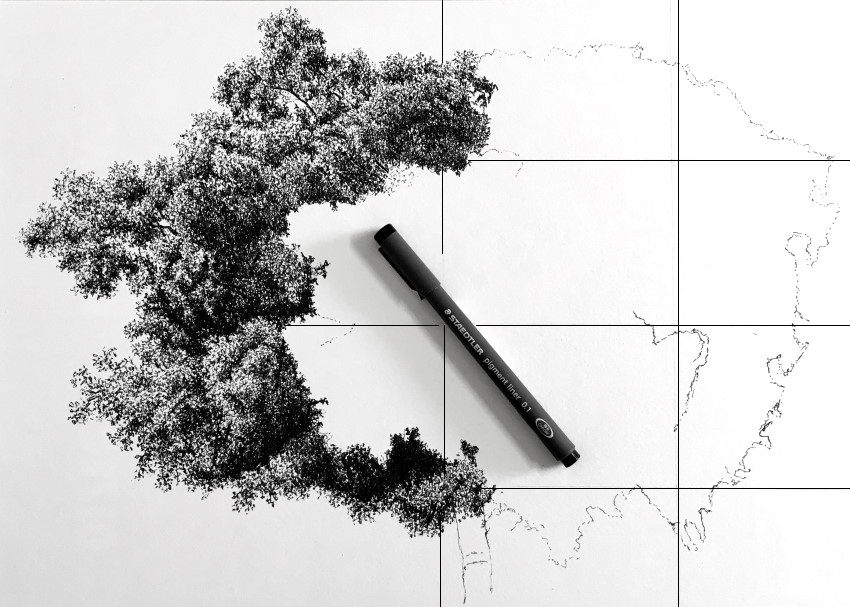
Proceed in mind:
Cartoon on a large newspaper with pen (or pencil) is fourth dimension-consuming. For a tree similar this it can easily accept more 20 hours to consummate.
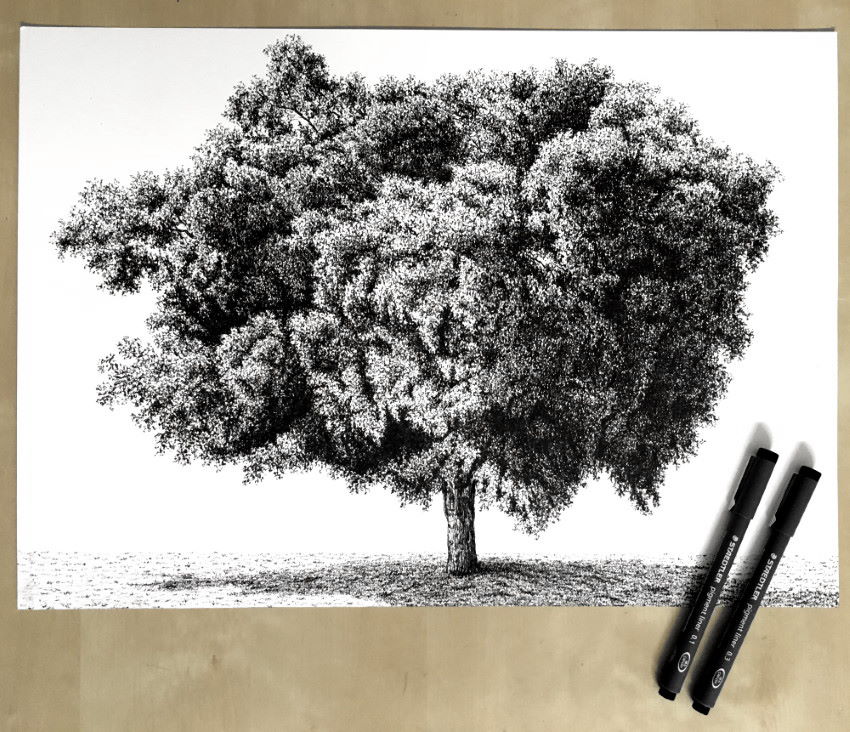 Ficus tree pen drawing
Ficus tree pen drawing
Sometimes, huge drawings may not look then big on a pocket-size screen.
We tin can give it context by adding background trees (from imagination in this case).
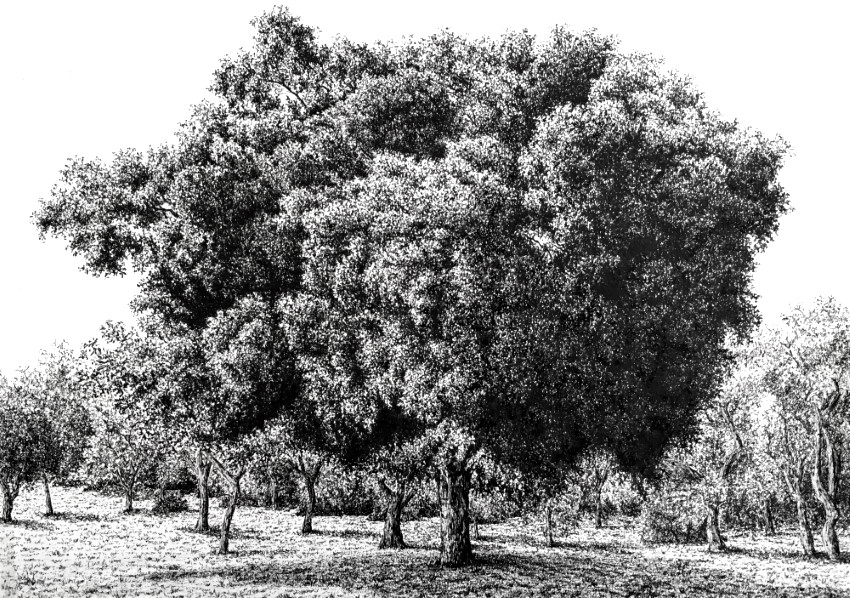 Background drawing
Background drawing
Something to consider:
We use the rules of atmospheric perspective when drawing backgrounds (mural).
When objects are far away, there are more atmosphere particles (that scatter light) between them and the observer.
For far abroad objects, nosotros apply less contrast and fewer details. In add-on, background layers will become lighter and have soft edges.
Calculation Background
Copse are beautiful on their own. Sometimes though, nosotros desire to add together a background.
Drawing grass is a uncomplicated and easy solution for background.
Beginning by drawing some curt lines. The lines in the front should be a flake bolder and longer.

Add more lines; some can be longer (generally in the foreground).
Avert whatever pattern and endeavor to be abstract with your marks.

With a tree (eucalyptus in this case), grass (as background) will add together depth.
At that place is no actual depth in a drawing, our paper sheet is flat. The higher we depict on our newspaper (until the horizon), the further away it will expect.
Past drawing cast shadow by the tree, we add together a sense of space to our drawing.
To describe cast shadow, add more marks (lines) for that expanse, to create the illusion of dark value.
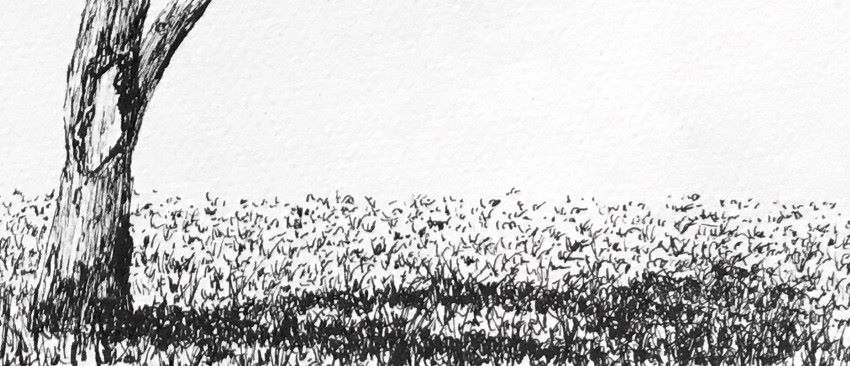
Adding Plants
Another selection is to add some plants. For example, cattail plant (Typha).
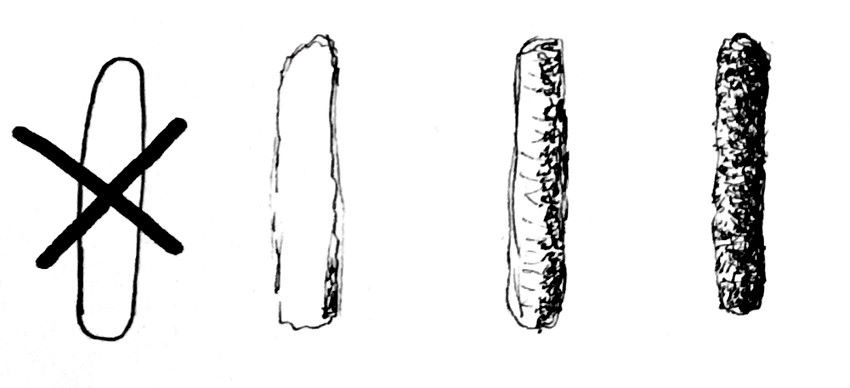
Retrieve:
Natural plants and trees have an abstruse shape. Make sure you do non draw them too round and compatible.
When drawing long leaves, pay attention to cast shadows:
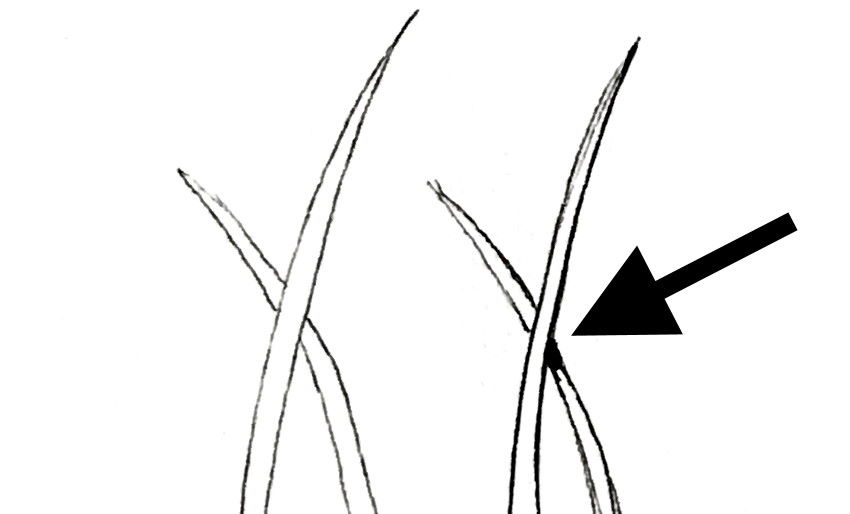
After examination-cartoon the plant's parts, draw some loose outlines.
For realistic results, draw each flower or leaf with unlike size, shape and direction (but, go on in mind the tree or institute characteristics).
Additionally, pay attention to overlapping.
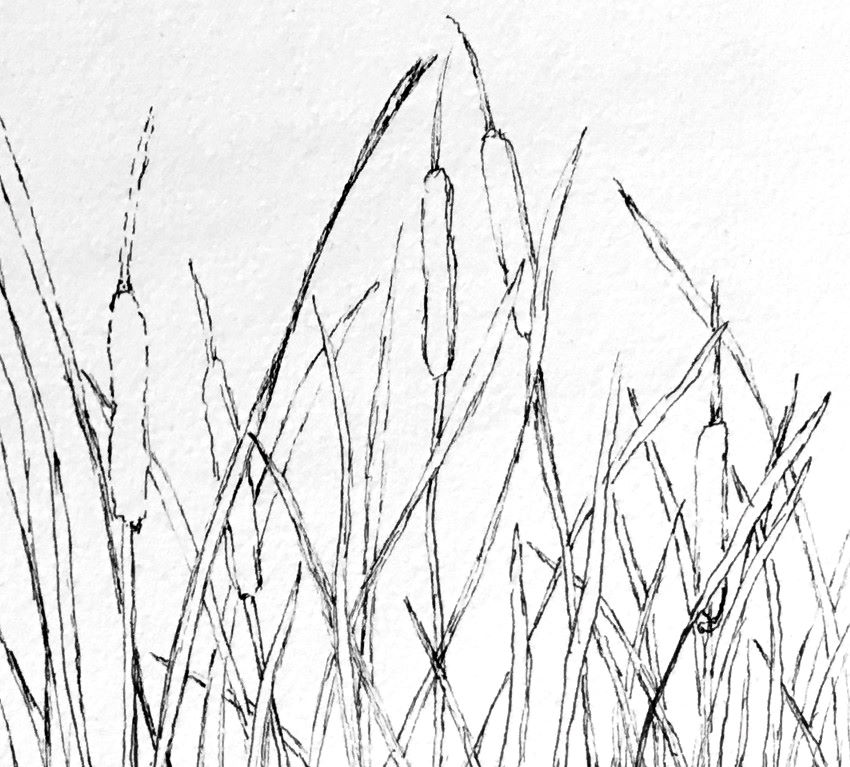
Then, add some effulgence values and cast shadows.
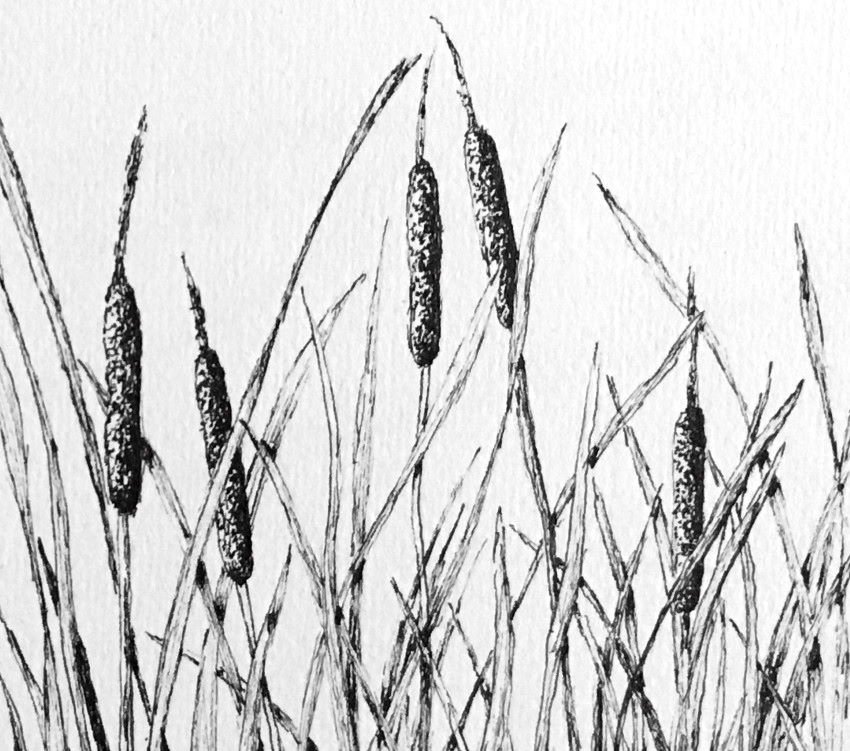 Cattail pen cartoon
Cattail pen cartoon
Now yous can combine grass and plants to draw a landscape.
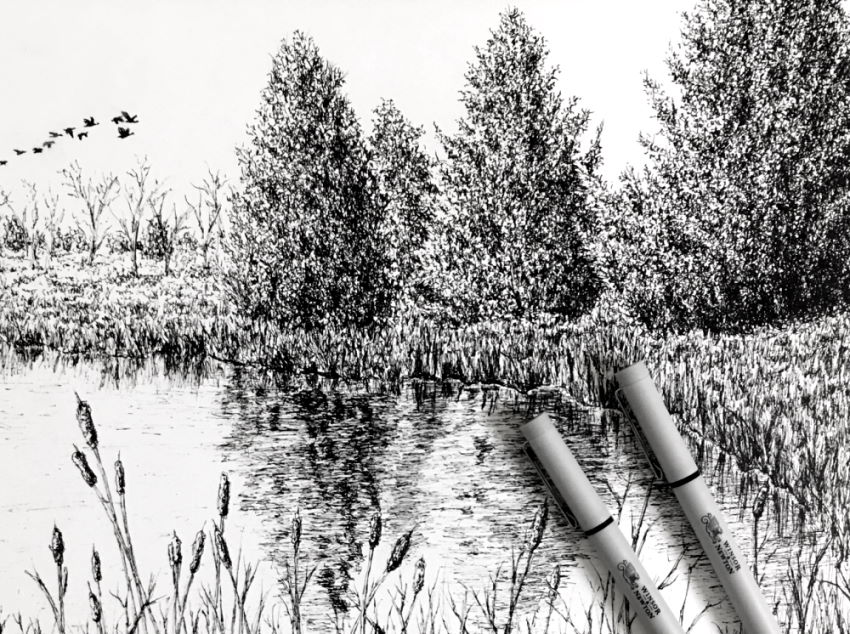 Mural pen drawing
Mural pen drawing
And paint it with markers.
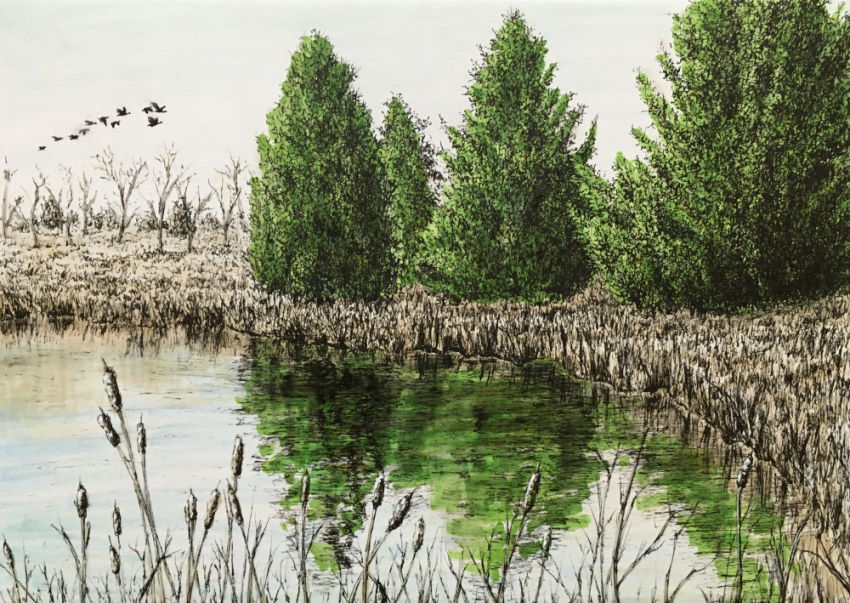 Coloring with markers
Coloring with markers
Size & Context
The manner to define the size of objects is past placing them near other familiar objects.
Although a worm is usually quite pocket-size, by drawing it big compared to known objects like trees, it is possible to create a giant monstrous worm.
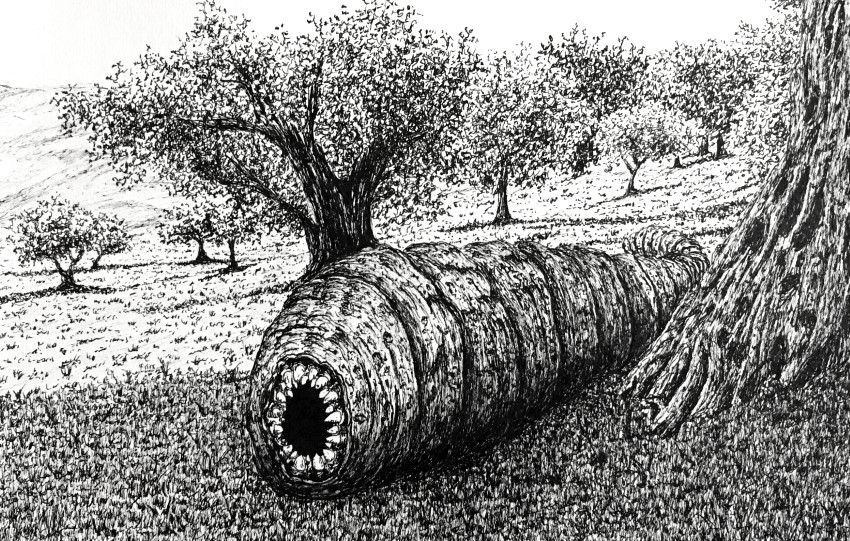 Giant worm
Giant worm
On the other mitt, we might want to draw a small-scale tree, like a bonsai tree.
In this case, we need context.
Drawing a tree in a plant pot can help, only sometimes fifty-fifty large trees are sold inside pots.
Drawing familiar surroundings, like a room, tin aid a lot in defining the bonsai's size.
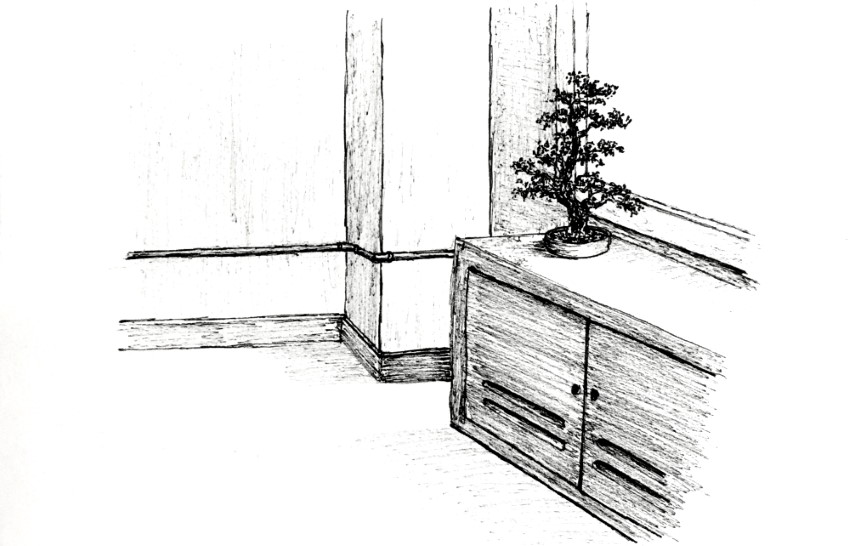 Bonsai tree
Bonsai tree
Summary
While there are no lines in nature, pens can only create lines!
Drawing is creating an illusion. The world is three-dimensional but our paper-canvas is ii-dimensional.
We create this illusion past paying attention to effulgence values, edges and transitions (among other things).
A pen has simply one brightness value, so, unlike other cartoon mediums (graphite, charcoal, pastel...), we have to create the illusion of dissimilar brightness values and transitions.
When drawing copse, focus on accuracy of the course and on effulgence values.
Accurateness in brightness values will create the illusion of depth and infinite.
Make sure y'all have enough contrast betwixt highlights and shadows for the drawing to exist noticeable.
After you lot main drawing the form and brightness values, details (texture) will make all the difference.
If you liked this article, yous might like my flower pen-drawing guide too.
For my recommended pens that I used in this guide, visit my review for fineliners and technical pens for cartoon.
![]()
![]()
Copyright © RanArtBlog.com. All Rights Reserved. | Sitemap
DOWNLOAD HERE
Step How to Draw a Pine Tree TUTORIAL
Posted by: jonthadjoble.blogspot.com